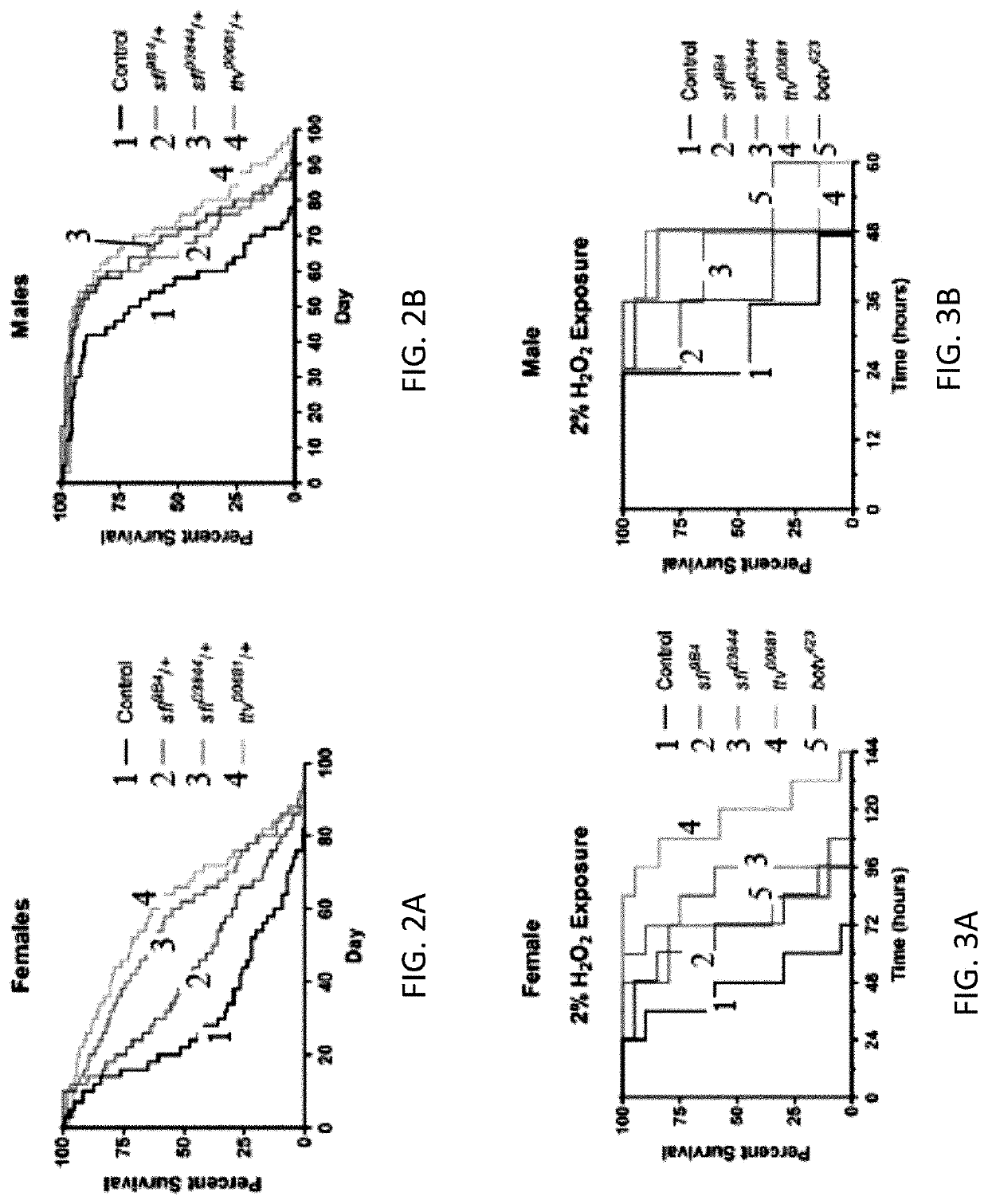Methods of treating neurodegenerative disease by inhibiting n-deacetylase n-sulfotransferase
- Summary
- Abstract
- Description
- Claims
- Application Information
AI Technical Summary
Benefits of technology
Problems solved by technology
Method used
Image
Examples
example 1
and Methods
Lifespan and Log-Rank Analysis
[0179]A typical experiment began with over 100 adult flies, Flies were examined for longevity on standard media at 25° C., 25-30 animals per vial, and transferred to new media every 48 hours. Mortality was scored every 48 hours. Significant deviation in survival curves was calculated first on the pooled genotypes by logrank test using the Mantel-Haenszei method, followed by pair-wise comparison between each experimental genotype and the control using the Gehan-Breslow-Wilcoxon test. No individuals were censored during the survival assay, and survival curves of the experimental genotypes do not cross that of the control.
[0180]Survival curves can be compared using the log-rank test to ascertain whether or not there are differences in the survival experiences of two genotypes. In the absence of censoring, the log-rank test assumes that survival probability is the same for individuals recruited at different time points and that mortality events h...
example 2
enes Required for Heparan Sulfate Biosynthesis Increase Autophagy-Dependent Cleavage of Atg8a in the Brain
[0195]Earlier work demonstrated that reducing heparan sulfate biosynthesis increased autophagy in muscle and fat body, the latter being the principle metabolic sensing and energy storage tissue in Drosophila. Given the critical role autophagy plays in neurodegenerative processes, the investigators sought to determine directly if heparan sulfate biosynthesis affects autophagy in the brain. Autophagy-mediated proteolysis produces cleavage of key components, including Atg8a, a protein involved in autophagosome formation. Monitoring Atg8a cleavage is therefore one measure of autophagy. To evaluate Atg8a proteolytic processing, an mCherry-Atg8a fusion protein was expressed in the brain using a UAS-mCherry-Atg8a construct and a neuron-specific Gal4 transcriptional activator. The resistance of the mCherry domain of the fusion protein to depradation allows the visualization of a relativ...
example 3
s of Heparan Sulfate Biosynthetic Gene Function Increase Lifespan
[0198]Increases in autophagy can extend lifespan, and longevity therefore provides a measure of autophagy function in the organism. Lifespan was evaluated in adult animals heterozygous for mutations in sfl or ttv, each affecting different components, of the heparan sulfate biosynthetic apparatus. Reducing the function of either of these two genes provided significant extension of lifespan compared to wild type control animals in both males and females (FIG. 2). Overall, ttv / + appears to increase lifespan to a greater degree than sfl / + animals. While the basis of these differences are not yet understood, heterozygosity for mutations in these genes does affect the levels and structure of the heparan sulfate polymer differently (see Table 1, below), perhaps accounting for the differential effects on lifespan. Together, these data provide evidence of the systemic impact of heparan sulfate modified proteins on the physiolog...
PUM
| Property | Measurement | Unit |
|---|---|---|
| Fraction | aaaaa | aaaaa |
| Interaction | aaaaa | aaaaa |
Abstract
Description
Claims
Application Information
 Login to View More
Login to View More - R&D
- Intellectual Property
- Life Sciences
- Materials
- Tech Scout
- Unparalleled Data Quality
- Higher Quality Content
- 60% Fewer Hallucinations
Browse by: Latest US Patents, China's latest patents, Technical Efficacy Thesaurus, Application Domain, Technology Topic, Popular Technical Reports.
© 2025 PatSnap. All rights reserved.Legal|Privacy policy|Modern Slavery Act Transparency Statement|Sitemap|About US| Contact US: help@patsnap.com



